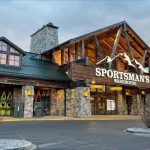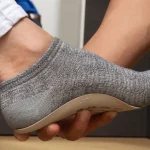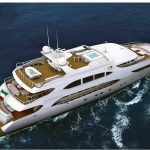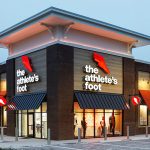The market took a sharp turn negative last week and many companies
serving the active sports lifestyle werent immune to the impact (see
chart page 1). The overall retail sales environment was certainly tough
for the five-week retail fiscal month of September. The obvious
impact of the warmer weather this year against the colder snap during
the same time last year, coupled with general concerns about the
economy and consumer spending outlook for the Holidays, had analysts
scrambling for answers at the most recent round of investor conferences
at the Wachovia Consumer Growth Conference in New York last week.
Hibbett Sports said its goal
going forward is to increase net square footage approximately 15% on an
annual basis. The company feels it can add 300 or 400 more stores in
the 23 states in which it currently operates. As evidence,
management noted that there is a 4:1 ratio of Wal-Mart stores to
Hibbett stores in those states. Hibbett looks for strip centers
that include or will include a Wal-Mart store, feeling that it benefits
from the larger retailers presence by offering better service and
product than can be found in WMT stores. Sales growth should be similar
to square footage growth. The company has 70% of its stores in strip
centers with the remained in enclosed malls. Going forward,
approximately 90% of all new store openings will be in strip center
locations
The company implemented its JDA merchandise system in February, at a
cost of approximately $4 million. HIBB will next focus on automatic
sales replenishment, known as E3, and then move on to price
optimization. The cost for the last two parts of this process should be
less cash intensive than JDA, costing “a couple million dollars for
IT.”
As for the current situation at retail and the climate forces causing a
mess for much of the country, Mickey Newsome, chairman and CEO of HIBB,
said, “its far too early for us to do any panicking related to
weather. Our footwear business has been a little better than expected.
Our apparel business has not been as good as expected.” Newsome went on
to say that he feels the consumer is becoming more picky and that
apparel had been better than footwear for most of the year, but the
last six to eight weeks has seen footwear “perform a little better than
expected.” Within footwear, he called out Asics, Nike, Mizuno and
New Balance as performing well, but said Reebok and K-Swiss were not as
strong. Private label currently accounts for “less than 2%” of overall
sales for HIBB.
Zumiez CEO Rick Brooks opened
his presentation by thanking the conferences schedulers, attendees and
the world in general for starting his talk off at 8 a.m. in the
morning, which really doesnt mesh with the companys counter culture.
The action sports retailer currently operates 275 stores in 26 states
and expects to grow to 500 to 800 stores nationwide, eventually. The
company continues to expect to grow square footage by approximately 20%
annually, opening 50 stores this year. While growing the store
base at that rate, ZUMZ expects to grow earnings by 30% this year. The
company will lose a week of sales in Q4, which it estimates accounts
for approximately $5 million. However, new stores should
contribute approximately 14% to 17% in sales growth on top of whatever
comparable store gains the retailer realizes.
Private label accounted for just over 14% of sales last year, but
management stressed that key for the retail concept to be successful is
the brands that drive the action sports industry and constantly finding
new, fresh brands to keep the consumer coming back.
Brown Shoe Corp. sees the opportunity to grow its Famous Footwear chain from a little over 1,000 stores currently to 1,500.
“We have identified priorities in terms of markets, and how we're going
to execute to that,” Mark Hood, Brown's CFO, said at Wachovia Consumer
Growth Conference.
Hood added that expansion, along with modest same-store sales growth
could add $700 million to $800 million in revenues towards Brown's
corporate goal of reaching $5 billion. The company currently does
$2.5 billion across its retail and wholesale divisions.
Among its strategies to drive Famous Footwear's organic growth is
capitalizing on technology to enable the chain to ship out-of-stock
sizes to customers.
“Whether it is in the store the customer is, one of our other stores,
or the distribution center, we want to be able to delight that customer
if not on-site that day by getting that pair of shoes to her
overnight,” said Hood. “That continues to be an item that adds growth.
We've seen that add 1% to 2% of growth over the last several years.”
Famous has opportunity to deepen penetration in key markets to leverage
areas such as distribution and advertising, and multi-store overheads.
Hood said this could increase its SG&A leverage there by some 150
to 200 basis points. He also said Famous Footwear will continue to
improve inventory turns, which were at 2.4 last year, up from 1.8 five
years before.
Perry Ellis International plans
to launch the Gotcha brand as an exclusive at Kohl's. The action sports
brand is being introduced in 160 Kohl's doors for April of next year.
Speaking at the conference, Oscar Feldenkreis, president and COO of
Perry Ellis International, said the company's action sports business,
which also includes Redsand and MCD, has “seen a tremendous amount of
increase” as retailers look to expand their action sports areas. He
noted that MCD is growing at core surf retailers, mentioning Jack's in
Huntington Beach as an example.
“We feel that Gotcha has a tremendous opportunity with the 160 doors
that we will be launching into Kohl's, as well as continuously building
the momentum on MCD, and the increased penetration of Redsand,” said
Feldenkreis.
Regarding swim, PERY is just starting a new season, but revenues last
year grew 50%, led by growth in Nike of more than 35%. Jag is also
seeing “excellent results” in swim in the department store sector.
“We see a tremendous opportunity now, going into next year with the
Beijing Olympics and the Nike brand,” said Feldenkreis. “A lot of the
retailers, especially in the sports channel, are gearing up for this
momentum, which should be very good for us going forward. Swim is a big
platform in the Summer Olympics.”
Perry Ellis's golf lifestyle business has been growing by 50%. Brands
include PING at the green grass channel, Champion Tour at Macy's, and
PGA Tour at JC Penney. PGA Tour, as well as Champion Tour, also sells
to the sports channel at retailers such as Modell's and Academy.
Perry Ellis is testing Grand Slam Golf with Kohl's in about 100 doors
for this holiday and spring '08 season, as well private label
businesses and branding with Belk's stores under the Pro Tour brand
starting this holiday
season.
lululemon athletica boosted
their third quarter guidance and the vertical retail chain is now
expecting comp sales increases in the mid-30's versus previous guidance
of mid- to high-teens. The main cause for this increase in sales is the
strengthening of the Canadian Dollar in relation to the U.S. Dollar. On
a constant dollar basis, the revised guidance translates into a
mid-20's percentage increase over 2006. Even though the increase in
sales is expected to be partially offset by the currency impact on
SG&A costs incurred in Canada , the company expects to exceed its
previous guidance of 5 cents to 6 cents earnings per share for the
third quarter.
LULU management also gave investors an update on their growth plans for
2008 and beyond at the Wachovia conference. The retailer is taking a
grassroots, specialty approach to its marketing by seeding product to
fitness and training professionals in local markets. “In my days at
Reebok and Nike and adidas, we were spending 15% of sales in marketing
through celebrity endorsement and TV ads. And you've got to do more and
more of it to get above the clutter,” Bob Meers, lululemons CEO said.
“We're spending less than 5% of sales and having much more direct
impact because that fitness community to that store becomes a gathering
place to create business and our involvement.”
The companys new store strategy is focusing on strategic markets and
clustering stores around those markets. Currently, the company has
identified several markets and has plans for up to 300 stores in the
U.S. and another 50 in Canada . The average footprint is about 2,500
square feet with a “minimum” contribution of $750 per square foot in
the first year of operation. This baseline gives the retailer just
under $1.9 million of sales per store. LULU spends about $825,000 to
open a store with about $500,000 per store in build-out costs,
pre-opening costs of about $175,000, and the balance going to initial
inventory and supplies for the store. This investment is paid back in
“no more than 18 months,” and in many cases faster than that.
On the sourcing side, the company has some unique strategies and
long-term viewpoints. Currently, 10% of the companys products come out
of Peru and Israel, with Peru being “a real key market for us,” because
it allows duty free access to Europe, the United States, and, shortly,
Canada. Management said that they are getting “very, very high quality”
product coming out of Peru and they are building a big
manufacturing footprint there.
Cabelas also updated its Q3
and full-year 2007 guidance. The company now expects revenues of
approximately $547 million, increasing 11.5% from the same period last
year. The revenue gain will come from a 4.2% increase in the companys
direct business and a 4.6% increase in same store sales. While the
top-line remains healthy, CAB management reduced guidance on earnings
due to margin pressures during the quarter. Now, CAB believes 2007
diluted earnings per share will increase at a “high single digit”
growth rate versus previous guidance of mid-teens.
Finally, Wolverine World Wide
filed its 10-Q with the Securities and Exchange Commission last week,
providing more details on all of its reporting segments. WWWs Outdoor
Group recorded revenue of $121.8 million for the third quarter, a 9.0%
increase over the third quarter of the prior year. Merrell accounted
for $15.0 million of the increase over the prior year, due to strong
results from the Outventure product categories and the launch of the
Merrell Apparel business. Sebago saw a $1.2 million revenue increase
and Patagonia Footwear contributed $3.8 million in revenue in the third
quarter.
The Wolverine Footwear Group recorded $61.8 million in revenue for the
third quarter of 2007, an 8.4% decrease from the third quarter of 2006.
The Wolverine brand business increased revenue by $4.1 million, while
the Bates uniform footwear business saw a decrease in revenue of $2.8
million in the quarter due to a reduction in demand from the U.S.
Department of Defense.
The Heritage Brands Group experienced a $200,000 decrease in revenue
during the third quarter of 2007 compared to the third quarter of 2006.
Cat Footwear's revenue decreased $2.5 million from the third quarter of
2006 due principally to difficult retail conditions and changes in
fashion trends away from the core product offerings in Canada and
Europe. Harley-Davidson Footwear revenue increased $2.3 million in the
quarter driven by improved retail sales and repeat customer orders in
the U.S. business.
The Hush Puppies Company recorded revenue of $47.7 million in the third
quarter of 2007, a $900,000 increase. The increase was primarily
attributable to strong growth of $1.0 million in the U.K. The
U.S. business saw revenue increase by $200,000 in the third
quarter.
Wolverine Retail reported a $300,000 increase in revenue as a result of
seven additional stores operating compared to the prior year's third
quarter, while recognizing a low single-digit same-store
revenue decrease. Wolverine Retail
operated 87 retail stores at the end of the third quarter of 2007,
increasing from 80 stores at the end of the third quarter of 2006.
With its low-cost structure, Gildan Activewear
has become the dominant supplier in the North American screenprint
channel, and continues to see additional opportunities for growth
there.
Speaking at the Wachovia Consumer Growth Conference, Laurence Sellyn,
Gildan's CFO, CAO and EVP, said the company sold approximately 500
million T-shirts into the North American screenprint channel in its
most recently completed fiscal year. In 100% cotton, the company
claims a 55% market share of the total T-shirt market year-to-date. In
blended 50% polyester, 50% cotton T-shirts, the same said its piece of
the market has grown to a 30% share. In fleece, Sellyn said the
companys market share is now in the low-40s. Sellyn said Gildan is
also the leader in the sport shirt category, and is introducing a
higher-end sport shirt for the corporate promotional market, which he
called “underserved at this time.”
Gildans' goal is to reach a 60% share in 100% cotton T-shirts as it
adds new capacity in Honduras and relocates manufacturing from Canada;
and, to achieve similar shares in 50/50 T-shirts, fleece and sport
shirts.
Overall, Sellyn mentioned three drivers behind GILs long-term growth
strategy. First, leveraging its business model for retail and
introducing basic knit socks and underwear for mass retail. Second,
pursuing international growth in both wholesale and retail. Third,
reinvesting its surplus-free cash flow to pursue selective
complementary acquisitions to complement its organic sales and earnings
growth.
Sellyn noted that Gildan's recently-closed acquisition of sock
manufacturer V.I. Prewett has helped Gildan become a full product line
supplier of not only socks, but also activewear and underwear for major
mass retailers. He said Gildan is looking for selective tuck-in
acquisitions, but is also looking to “identify longer-term strategic
growth opportunities for future new core businesses which will lever
[GILs] core competencies and competitive advantages.”
Iconix Brand Group, Inc. plans
a small launch for its Ocean Pacific/OP brand at Wal-Mart in February
2007 with a major rollout in early April for late spring/summer. As
previously reported, Iconix signed an exclusive license agreement with
Wal-Mart for its Ocean Pacific and OP brands.
Speaking at the Wachovia Consumer Growth Conference, David Conn,
Iconix's EVP, said the OP collection will include junior sportswear,
men's sportswear, kids' sportswear, swimwear and accessories.
“We're working with an outstanding new team of merchants at Wal-Mart
that are energized and excited and in our opinion have a tremendous
vision for OP,” said Conn.
Conn also noted that Iconix recently signed a major license agreement
in Europe for the OP brand, and he was enthused that Wal-Mart had also
attained OP rights for Brazil, India and China .
“Over the next three months, we're going to be in all three of those
markets, meeting with the merchants at Wal-Mart, talking about how we
can potentially launch OP in those markets,” said Conn.
Iconix now has 188 licensing deals among its 15 brands. Of those, eight
are direct-to-retail such as the Wal-Mart exclusive. OP is the second
with Wal-Mart, which also licenses Iconix's Danskin Now brand.
Women's, led by MLB merchandise, has been a star performer in G-III Apparel Group's sports licensing division.
“We have licenses with the four major leagues, over 100 universities,
and we're actually getting some great growth now in the women's active
area,” said Wayne Miller, G-III's COO at the Wachovia Consumer
Growth Conference. The division includes outerwear and sportswear.
Miller said G-III just signed a new higher-end initiative with Alyssa
Milano, the actress, called “Touch by Alyssa Milano.” G-III is also
working on a mid-tier concept with Milano for its sports licensing
business.
Miller also said G-III is exploring acquisitions in the sports area, as well as in its dress, suit and coat divisions.
“An acquisition target probably ranges anywhere from $50 to $100
million in annual sales. We want them to be profitable. We want a good
management team that fits in with the work ethic of our company today,”
said Miller.















